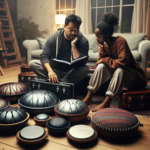The handpan is a relatively new musical instrument that has captivated the hearts of musicians and listeners worldwide. Its ethereal and harmonious tones are produced by striking the various notes arranged around its surface. However, a significant factor contributing to its mysterious and enchanting sound is the scale in which the handpan is tuned. The choice of scale can dramatically change the mood and character of the music being played. In this article, we will delve into the unique qualities of different handpan scales and explore how they shape the instrument’s voice.
The Basics of Handpan Scales
Before we dive into specific scales, it’s essential to understand what a scale is. In musical terms, a scale is a series of notes ordered by pitch. The sequence and intervals between these notes define the scale’s unique sound and character. Handpans are typically tuned to a specific scale, and each note on the handpan corresponds to a note in that scale.
Handpan scales can be broadly categorized into major, minor, and exotic scales, each offering a distinct emotional palette. Major scales often convey a sense of happiness and positivity, while minor scales evoke melancholy and introspection. Exotic scales, on the other hand, can transport listeners to different cultural and emotional landscapes.
Major Handpan Scales
Major scales are among the most universally recognized in music. They are characterized by their bright and uplifting sound. The notes in a major scale follow a specific pattern of whole and half steps, giving them their unique tonal quality.
- D Major: The D major scale is a popular choice for handpans. It features the notes D, E, F#, G, A, B, and C#. This scale is known for its joyful and vibrant sound, making it suitable for creating cheerful and upbeat music.
- C Major: Another commonly used major scale is C major, which includes the notes C, D, E, F, G, A, and B. This scale is versatile and can evoke a sense of simplicity and innocence, making it a favorite for both beginners and experienced players.
Minor Handpan Scales
Minor scales, in contrast to major scales, exude a sense of melancholy and introspection. They are often used to create music that conveys deep emotions and contemplative moods.
- D Minor: The D minor scale, consisting of the notes D, E, F, G, A, Bb, and C, is a popular choice for those seeking a haunting and introspective sound. It’s ideal for creating music that reflects on themes of sorrow and introspection.
- A Minor: The A minor scale includes the notes A, B, C, D, E, F, and G. This scale is known for its versatility, capable of evoking a wide range of emotions from sadness to mystery.
Exotic Handpan Scales
Exotic scales offer a world of sonic possibilities, often drawing inspiration from different cultural traditions. These scales can transport listeners to far-off lands and evoke a sense of adventure and wonder.
- Hijaz Scale: The Hijaz scale, rooted in Middle Eastern music, features the intervals of a half step, augmented second, and half step. It gives the music a distinct Arabian flair. A common Hijaz handpan scale is the D Hijaz, with notes D, Eb, F#, G, A, Bb, and C.
- Pygmy Scale: The Pygmy scale has its origins in African music and offers a unique, rhythmic quality. It typically includes the notes C, Eb, F, G, Bb, and C. This scale is perfect for creating earthy and tribal rhythms.
- Kurd Scale: The Kurd scale is another scale that brings an Eastern flavor to the music. The D Kurd, for instance, includes the notes D, E, F, G, A, Bb, and C, offering a sense of mystique and ancient traditions.
Choosing the Right Scale for Your Handpan
Selecting the right scale for your handpan is a deeply personal decision. It’s essential to consider your musical goals, emotional preferences, and the type of sound you wish to create. Many handpan players choose a scale that resonates with them emotionally, allowing them to express their feelings through the instrument.
It’s also worth noting that the choice of scale can influence the player’s technique. Certain scales may require more precise finger movements and hand coordination, while others may be more forgiving. Additionally, some scales lend themselves well to specific genres of music, so consider what type of music you want to play when choosing a scale.
Exploring Different Handpan Makers
The handpan community is blessed with a wealth of talented makers who craft instruments in various scales and tunings. Exploring different handpan makers can be an exciting journey, as each craftsman brings their unique touch to the instrument’s sound and build quality.
Some prominent handpan makers include PANArt, Yishama, Ayasa, and SPB (Sensus Pan Band). These makers often have signature scales and tunings that set their instruments apart. Trying out handpans from different makers can help you find the perfect instrument that resonates with your musical style and preferences.
Conclusion
The handpan’s enchanting sound is deeply influenced by the scale in which it is tuned. Whether you choose a major, minor, or exotic scale, each brings its unique emotional and sonic qualities to the music you create. Understanding the characteristics of different handpan scales allows you to choose the right one for your musical journey, enabling you to express your emotions and melodies with authenticity.
As you explore the world of handpan scales and experiment with different tunings, you will discover a rich and diverse musical landscape waiting to be explored. So, whether you’re a seasoned player or a newcomer to the handpan, take the time to explore the enigmatic sounds of different scales and let your creativity and emotions flow through this captivating instrument.
FAQs
- What is a handpan scale? A handpan scale is a sequence of musical notes arranged in a specific pattern of intervals. Each handpan is tuned to a particular scale, which defines the notes that can be played on it and shapes its overall sound and character.
- How do I choose the right handpan scale for me? Choosing the right handpan scale is a personal decision that depends on your musical goals and emotional preferences. Consider what type of music you want to play, the emotions you wish to convey, and try out different scales to find the one that resonates with you the most.
- Can I retune my handpan to a different scale? Retuning a handpan is a complex process that requires specialized knowledge and skills. It’s generally not recommended to retune a handpan yourself, as it can damage the instrument. If you wish to change the scale, it’s best to consult a professional handpan tuner or maker.
- What are some popular exotic handpan scales? Popular exotic handpan scales include the Hijaz scale, Pygmy scale, and Kurd scale. These scales draw inspiration from different cultural traditions and offer unique sonic qualities that can evoke a sense of adventure and wonder.
- Who are some renowned handpan makers? Renowned handpan makers include PANArt, Yishama, Ayasa, and SPB (Sensus Pan Band). Each maker has their signature scales and tunings, and exploring instruments from different makers can help you find the perfect handpan for your musical style and preferences.





